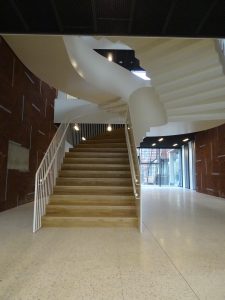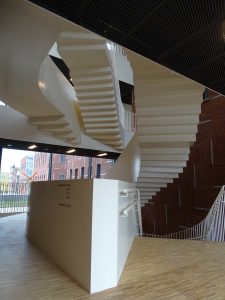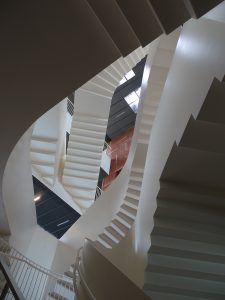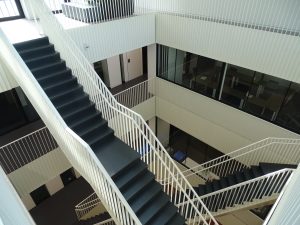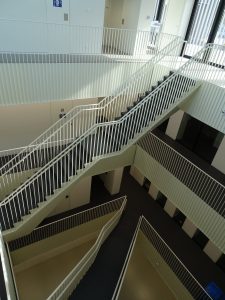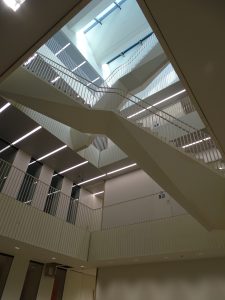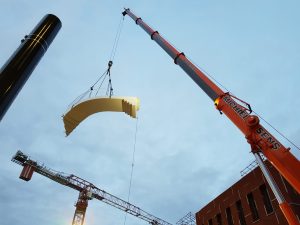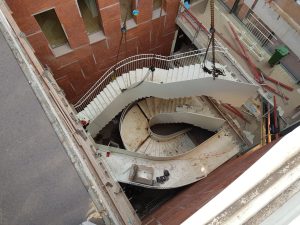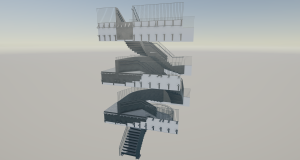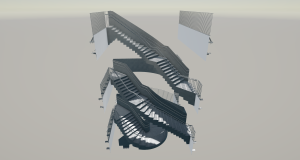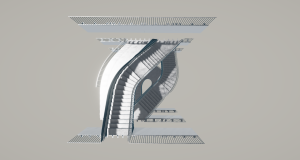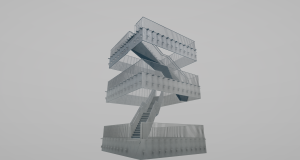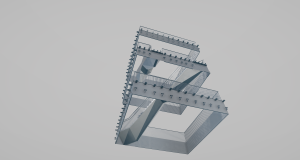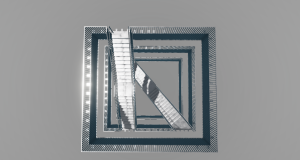Trappen en bordessen politiekantoor en administratief centrum, Beveren
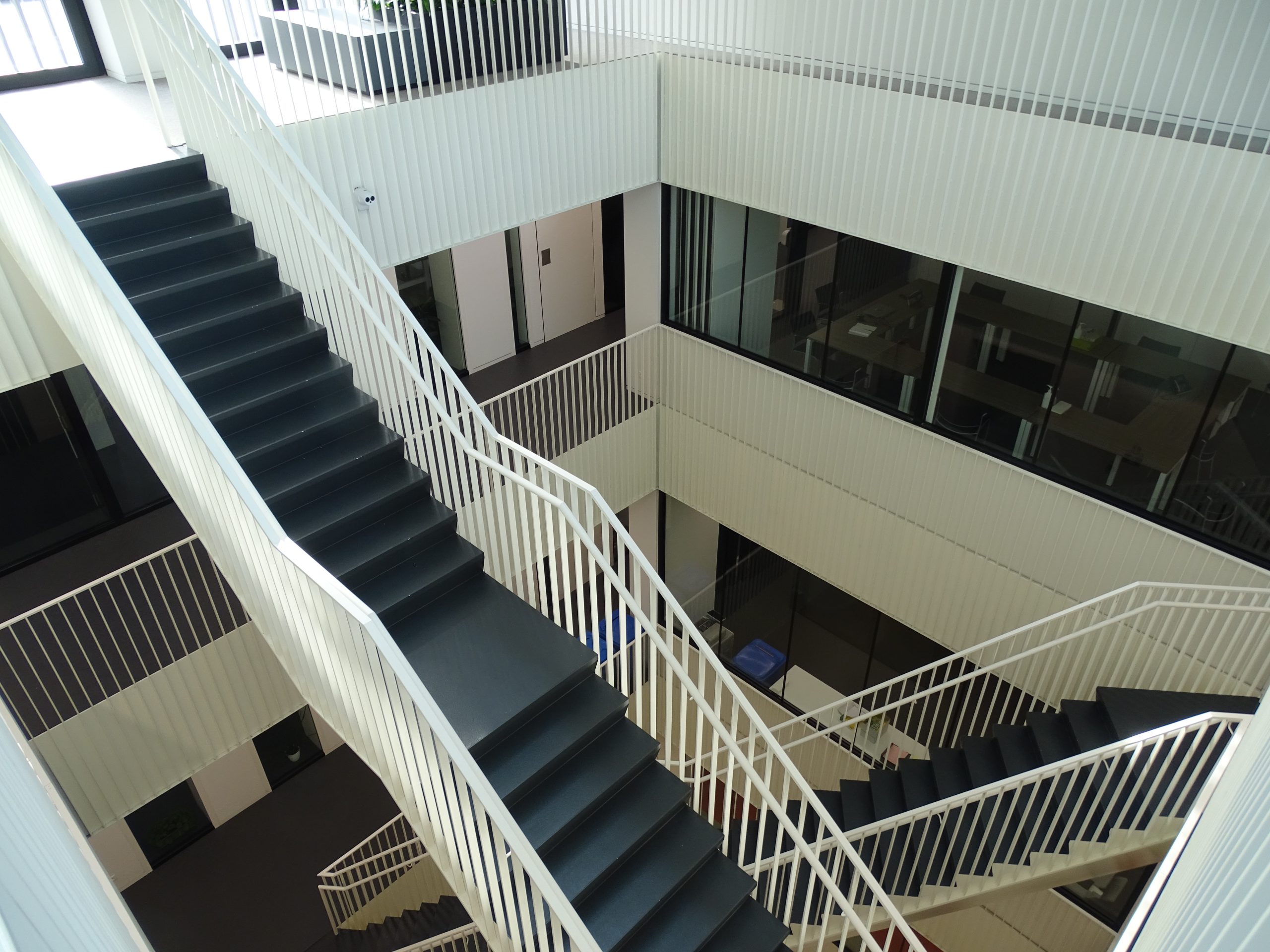
| Category | Small Scale Projects |
|---|---|
| Year | 2024 |
| Country | Benelux |
| Organization | Metalprojects NV |
| Project partners | ORG-Permanent Modernity, Democo NV |
| Author | Cristian Cionoiu |
| Client | Stad Beveren |
| Place of construction | Beveren, België |
| Tags | Tekla StructuresTrimble ConnectSteel |
Het project
Een nieuw politiekantoor en administratief centrum rondom het centrale plein van Beveren ontworpen door ORG-Permanent Modernity.
Het politiekantoor en de afdelingen van het stadhuis zijn elk gehuisvest in één L-vormig gebouw.
In het midden van het politiegebouw zijn er twee lange trappen geplaatst, die alle kantoren, vergaderruimtes en andere ruimtes met elkaar verbinden, zowel functioneel als visueel. De trappen lopen door een vierkante vide over een hoogte van vier verdiepingen. Het dak is voorzien van glas , zodat de vide licht brengt in het hart van het gebouw. De trappen zijn gemaakt uit wit gelakt staal. Dankzij hun geometrie kunnen ze erg smal worden gemaakt, wat de transmissie van licht en zichtbaarheid aanzienlijk verbetert.
Op de kruising van het politiekantoor en de stadsdiensten bevindt zich een entreevolume. In het entreevolume zijn er trappen en passerellen ondergebracht om de verschillende verdiepen te bereiken. Het ontwerp van het gebouw omvat vele 3D vormen, zoals vooral aan de buitenzijde stalen mesh en betonnen sculpturen. Binnen in het entreevolume werden er 3 trappen en 2 passeren ontworpen met 3D-vormen die de eyecatcher zijn als je het gebouw betreedt.
Uitdagingen
De trappen in het politiekantoor zijn zeer lang en zijn zeer smal om een grote transparantie te houden in de vide. De moeilijkheid van de trappen is de speciale vorm van de onderzijde die conisch uitloopt en mee moet knikken met de bordessen in de trap. De vorm van de onderzijde doet denken aan de onderzijde van een schip, deze moet ook de sterkte geven aan de trap. De aansluiting van de videleuningen met de aangelaste trapleuningen was ook niet evident. Het geheel oogt zeer fijn en licht, maar moest natuurlijk wel aan de stabiliteitsnormen voldoen.
De trappen in het entreevolume zijn meer complexere vormen die gebogen zijn en een dubbele bodem hebben, enerzijds voor de sterkte van de trappen en anderzijds voor het decoratieve geheel. De vloeiende bewegingen die de trappen voorstellen waren echt niet evident om ten eerste al uit te tekenen en daarna uit te voeren. De trappen werden zoals reeds gezegd met een dubbele bodem gemaakt om de sterkte te garanderen, wat een grote uitdaging was. De passerellen werden op dezelfde manier opgebouwd. De onderste trap werd in delen binnengebracht en ter plaatse nog aan elkaar gelast. De andere trappen en passerellen konden we in 1 stuk vervoeren en binnenbrengen.
The project
A new police station and administrative centre around Beveren’s central square designed by ORG-Permanent Modernity.
The police station and city hall departments are each housed in one L-shaped building.
At the centre of the police building, two long staircases are placed, connecting all offices, meeting rooms and other spaces, both functionally and visually. The stairs run through a square void over a height of four floors. The roof is glazed , so that the void brings light into the heart of the building. The stairs are made of white painted steel. Their geometry allows them to be made very narrow, significantly improving light transmission and visibility.
An entrance volume is located at the intersection of the police station and city services. The entrance volume houses stairs and passerelles to reach the different floors. The design of the building includes many 3D forms, such as steel mesh and concrete sculptures especially on the outside. Inside the entrance volume, 3 staircases and 2 passages were designed with 3D shapes that are the eye-catcher when you enter the building.
Challenges
The stairs in the police station are very long and are very narrow to maintain great transparency in the void. The difficulty of the stairs is the special shape of the underside, which tapers out conically and has to articulate with the landings in the stairs. The shape of the underside is reminiscent of the underside of a ship; it must also give strength to the stairs. The connection of the side railings with the welded-on banisters was also not obvious. The whole thing looks very fine and light, but of course it had to meet stability standards.
The stairs in the entrance volume are more complex forms that are curved and double-bottomed, on the one hand for the strength of the stairs and on the other for the decorative whole. The flowing movements represented by the stairs were really not obvious to draw out first of all and then execute. As already mentioned, the stairs were made with a double bottom to ensure strength, which was a big challenge. The passerelles were constructed in the same way. The bottom staircase was brought in in parts and still welded together on site. We were able to transport and bring in the other stairs and passerelles in one piece.
